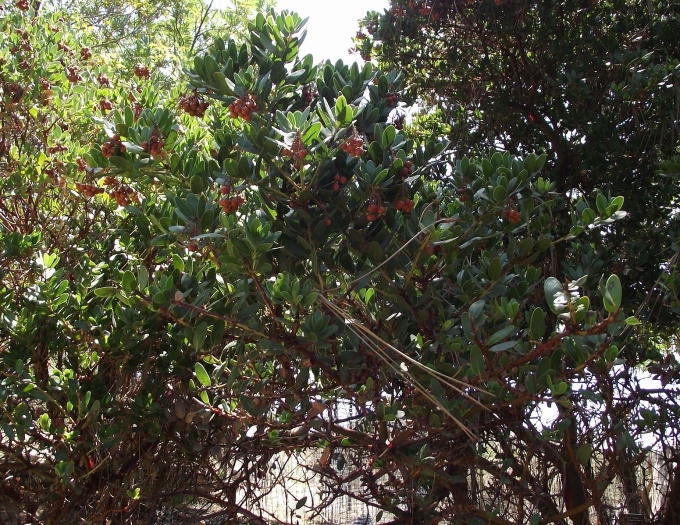Island Manzanita
(Arctostaphylos insularis)
Island Manzanita (Arctostaphylos insularis)
/
/

Tortie tude
CC0
Image By:
Tortie tude
Recorded By:
Copyright:
CC0
Copyright Notice:
Photo by: Tortie tude | License Type: CC0 | License URL: https://creativecommons.org/licenses/by-sa/2.0 | Uploader: Tortie tude | Publisher: Wikimedia Commons |



























Estimated Native Range
Summary
Arctostaphylos insularis, commonly known as Island Manzanita, is an evergreen shrub native to the chaparral and coastal sage scrub habitats on Santa Cruz Island, part of California’s Channel Islands. This species is adapted to dry, rocky conditions and is often found on slopes and ridges. It is a large, spreading shrub that can reach over 2 meters (6 ft 7 in) tall and is known to exceed 5 meters (16 ft 5 in) in width. The plant is characterized by its waxy, reddish bark and smaller twigs that sometimes have bristly glandular hairs. The leaves are shiny green, smooth, generally oval in shape, slightly convex, and up to about 4.5 centimeters (1+3⁄4 in) long. Island Manzanita blooms with many dense clustered inflorescences of urn-shaped flowers, which are typically white to pink and appear from winter to early spring. The fruit is an orange-brown drupe up to 1.5 centimeters (5⁄8 in) wide, which can attract birds and other wildlife.
Island Manzanita is valued for its striking appearance, with its attractive bark and foliage, and its ability to thrive with minimal care, making it suitable for xeriscaping and native plant gardens. It is used in cultivation for habitat restoration, erosion control, and as an ornamental in water-wise landscaping. This shrub prefers full sun to part shade and is highly drought-tolerant, requiring very low amounts of water once established. It adapts to a range of soil types, provided they have good drainage. While generally disease-resistant, it can be susceptible to fungal diseases if conditions are too wet. Gardeners should be aware that this species can be difficult to transplant due to its sensitive root system.CC BY-SA 4.0
Island Manzanita is valued for its striking appearance, with its attractive bark and foliage, and its ability to thrive with minimal care, making it suitable for xeriscaping and native plant gardens. It is used in cultivation for habitat restoration, erosion control, and as an ornamental in water-wise landscaping. This shrub prefers full sun to part shade and is highly drought-tolerant, requiring very low amounts of water once established. It adapts to a range of soil types, provided they have good drainage. While generally disease-resistant, it can be susceptible to fungal diseases if conditions are too wet. Gardeners should be aware that this species can be difficult to transplant due to its sensitive root system.CC BY-SA 4.0
Plant Description
- Plant Type: Shrub
- Height: 3-6 feet
- Width: 3-6 feet
- Growth Rate: Moderate
- Flower Color: Pink, White
- Flowering Season: Spring, Winter
- Leaf Retention: Evergreen
Growth Requirements
- Sun: Full Sun, Part Shade
- Water: Very Low
- Drainage: Fast, Medium, Slow
Common Uses
Bank Stabilization, Bee Garden, Bird Garden, Border Plant, Butterfly Garden, Deer Resistant, Drought Tolerant, Hummingbird Garden, Low Maintenance, Salt Tolerant
Natural Habitat
Native to chaparral and coastal sage scrub habitats on Santa Cruz Island
Other Names
Common Names:
Scientific Names: , Arctostaphylos insularis, Arctostaphylos insularis f. pubescens, Arctostaphylos insularis var. pubescens, Arctostaphylos insularis var. insularis, Uva-ursi insularis,
GBIF Accepted Name: Arctostaphylos insularis Greene & Parry